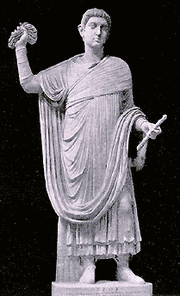- For the category list, see Magistrates.

Statue of fourth century CE Magistrate throwing down mappa before chariot race starts.
The magistrates of the Roman Republic were the high government officers of the Roman Republic, combining judicial and executive authority throughout Roman territory. The allied cities of the Republic beyond Rome, such as Pompeii and Capua, also possessed city magistrates, but the authority of these city magistrates was subject to the superior power of the Roman magistrates. The citizens of all cities of the Italian peninsula south of the Rubicon and Arno Rivers had been made Roman citizens at the end of the Social War in 88 B.C., making the authority of the magistrates of those cities subordinate to that of Roman magistrates.
Roman magistrates at the time of the Third Servile War were either ordinary, chosen at regular intervals: the Consules, Censores, Praetores, Aediles Curules, and Quaestores; or extraordinary, chosen only under special circumstances: the Dictator, Magister Equitum, and Interrex. The consuls, praetors, and dictator possessed imperium derived from the former regal power of the king (the interrex had it for five days only); they and the censors (who, though, did not hold imperium), who derived their duties from the former responsibilities of the kings, constituted the higher magistrates, magistratus maiores. Magistrates possessed of imperium were authorised to command armies in the field and to rule conquered territory with unquestioned authority during their time in office. The rest were the lower magistrates, minores. The consules, censores, and praetores were elected by the more aristocratic Committee of Centuries, while the quaestores and aediles curules were elected annually by the Committee of Tribes.
In addition to the magistrates, political power was also vested in two offices elected by the Committee of Plebians: ten tribuni plebis, and two Aediles Plebis. Since these officers were not elected by the whole body of the Roman citizens as represented by the Committee of Tribes or the Committee of Centuries, they were not formally speaking magistrates, but the power exercised by the tribune made the office the single most powerful in the Roman Republic at the time of the Third Servile War. The Aediles Plebis exercised power indistinguishable in most instances from those of the aediles curules.
Two censors were elected for an 18-month term every five years. The other magistrates were elected annually for a one-year term. At the time of the Third Servile War, two consuls, eight praetors, two aediles curules, and twenty quaestors were elected each year.
The rank of the magistrates was important, since one magistrate could veto the actions of another magistrate of equal or lesser rank. Censors held the highest authority, and the action of a censor could be vetoed only by the other censor, or by a tribunus plebis. The censors' primary responsibilities were the conduct of the census, sorting Roman citizens into the appropriate classes for the Committee of Centuries and taxation, and maintaining the mos maiorum, the ethical requirements of Roman citizenship. Consuls ranked next, and were the heads of the Roman state and army. The praetors, the state judges who could also command armies in the absence of the consuls ranked next. Next ranked the aediles curules, who were responsible for the care of city structures and the public games, and finally the quaestors, who managed the finances and taxes of the Republic.
Magistrates holding imperium, along with aediles curules, were entitled to a seat of honor, called the sella curulis, representing the historical linkage of their power to the thrones of the Roman kings, and to bodyguard-attendants called lictors, the number of such attendants varying with the rank of the magistrate. All magistrates entitled to the sella curulis were also permitted to wear the toga praetexta as a badge of honor, a toga with a broad purple stripe at the shoulder.
The hierarchy of the magistrates also became, by the time of the Third Servile War, a career trajectory for office-holders known as the cursus honorum. A man had to hold each of the lower offices in turn before running for the next office in the hierarchy, although the office of aedile curulis, because of the great personal expense associated with its responsibilities of sponsorship of public games and maintenance of civic buildings, was not required before seeking higher offices.
Roman magistrates received no salaries whatsoever. A magistrate nonetheless held great power of patronage, since the notion of separation of the public and private interests of a magistrate was largely foreign to Roman sensibilities, and self-dealing and outright bribery of magistrates became increasingly routine in the later days of the Republic.
Outside of Rome, less refined versions of the Roman political system existed in numerous Civitates or city-entities across the Republic, usually in the Coloniae (Roman citizen colonies in conquered territory) or the Municipia (former independent states granted Roman citizenship). Governing bodies in the external cities were called Curia, or "gathering of men". The members of the local Curiae were variously termed as Curiales or Decuriones, who selected from the wealthiest and most influential citizens of the city. In comparison to the Senators of Rome, their status was nothing higher than that of the Equasters or Equestrians (mercantile class), which they actually were, but in cities such as Capua, Neapolis, Pompeii, Arretium, Vellitri and Ariminum, would be the senatorial class within those individual cities. The head magistrates within an individual Civitates were the Douviri or Duumviri, meaning "rule of two men". A Duumvir (singular) was the equivalent of a city mayor, and were basically consuls on a strictly local level. The full title of this political office was the Duumviri Iuri Dicundo. Beneath the Duumviri were the Aediles, who like their counterparts in Rome, supervised the public games, markets police duties and the maintenance of public buildings.